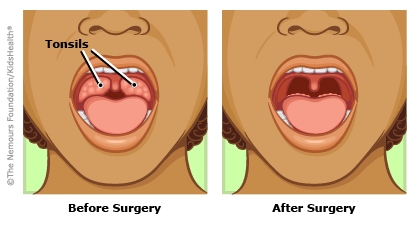Tonsillectomy
What Is a Tonsillectomy?
A tonsillectomy is surgery to remove the tonsils. Tonsils are lumps of tissue on both sides of the back of the throat that help the immune system protect the body from infections.
Tonsillectomy (tahn-suh-LEK-tuh-mee) is one of the most common surgeries kids and teens get.
Why Are Tonsillectomies Done?
Kids usually have a tonsillectomy because:
- Their tonsils are so big they block the airway and make it hard to breathe. Swollen tonsils can make it hard to breathe, especially during sleep. A child might snore and stop breathing for short periods while asleep when the tonsils get in the way. This is called obstructive sleep apnea. Apnea can make kids miss out on healthy, restful sleep, which can lead to learning, behavior, growth, and heart problems.
- Their tonsils get infected often. A health care provider might recommend removing the tonsils if a child gets a lot of tonsil infections (called tonsillitis). Experts define "a lot" as when a doctor diagnoses a child with at least 7 infections a year, more than 5 infections a year for 2 years in a row, or three infections a year for 3 years.
What Happens Before a Tonsillectomy?
Your health care provider will let you know if your child should stop taking any medicine in the week or two before the surgery. You'll also be told when your child should stop eating and drinking because the stomach must be empty on the day of the procedure.
Surgery, no matter how common or simple, can be scary for kids. Help prepare your child by talking about what to expect.
What Happens During a Tonsillectomy?
An ear, nose, and throat (ENT) surgeon will do the surgery while your child is under general anesthesia. This means an anesthesiologist will keep your child safely and comfortably asleep during the procedure.
The surgery is done through your child's open mouth. There are no cuts through the skin and no visible scars.
The two main types of tonsillectomy surgery are:
- Traditional tonsillectomy: Both tonsils are completely removed.
- Intracapsular tonsillectomy: The surgeon removes all the affected tonsil tissue, but leaves a small layer to protect the throat muscles underneath. There's a very slight chance that the remaining tissue can re-grow or become infected and need more tonsil surgery, but this isn't common.
With this type of surgery, kids:- recover faster
- have less pain
- don't need as much pain medicine
- have a lower risk of bleeding
- are better able to eat and drink after the procedure
Sometimes, when they remove the tonsils, doctors also remove the adenoids.
Can I Stay With My Child During a Tonsillectomy?
Usually, you can stay with your child until just before the surgery. Then you’ll be with them again as they wake up after it's over.

What Happens After the Tonsillectomy?
Your child will wake up in the recovery area. Many kids go home the same day, though some may stay overnight. In general, kids under 3 years old and those with serious sleep problems (like apnea) usually stay overnight.
Depending on the type of surgery done, recovery after a tonsillectomy may take a week or more. Expect some pain and discomfort after the tonsils are removed, which can make it hard for kids to eat and drink.
Are There Any Risks From Tonsillectomy?
There are risks with any surgery, including infection and problems with anesthesia.
Sometimes children get dehydrated from not drinking enough when they go home, and may need to come back to the hospital for fluids.
Rarely, bleeding might happen during the surgery, right after it, or up to 2 weeks later. Call the doctor right away if your child coughs up, throws up, or spits out bright red blood or blood clots. Doctors might need to do another procedure to stop the bleeding.
How Can I Help My Child Feel Better?
Give your child pain medicine as directed by your health care provider.
Kids should rest at home for a few days following surgery and take it easy for a couple of weeks. They can return to school or childcare when they can eat normally, are sleeping well, and don't need pain medicine.
Offer plenty to drink, and soft foods like pudding, soup, gelatin, or mashed potatoes until your child is ready for solid foods.
When Should I Call the Doctor?
Call the doctor if your child:
- gets a fever
- vomits after the first day or after taking medicine
- has a sore throat despite taking pain medicine
- isn't drinking enough liquids
Call the doctor right away if your child vomits blood or something that looks like coffee grounds, or has trouble breathing.
What Else Should I Know?
After tonsillectomy, kids can still get colds, sore throats, and throat infections. They won't get tonsillitis unless the tonsils grow back, which is uncommon.
Even though the tonsils are part of the immune system, removing them doesn't affect the body's ability to fight infections. The immune system has many other ways to fight germs.
